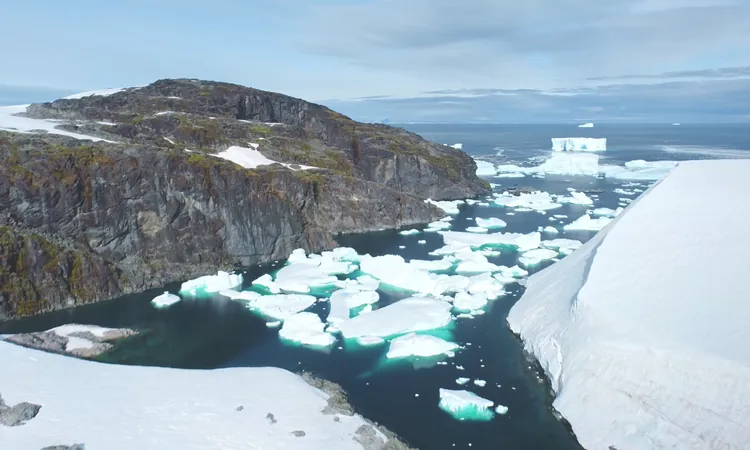
Unveiling Antarctica's Hidden Rivers: The Key to Accurate Sea-Level Predictions?
2025-03-27
Author: Mei
When most people picture Antarctica, they envision a vast, unchanging expanse of ice. Yet, beneath this colossal ice sheet lies a dynamic and unpredictable environment that scientists are only beginning to comprehend.
Recent research analyzing 34 million years of geological data reveals that subglacial waterways could dramatically alter our predictions regarding future sea-level rise. Anna-Mireilla Hayden, a PhD candidate from the University of Waterloo and the study's lead author, warns against overlooking these concealed rivers, stating that they could lead to unexpected challenges in our understanding of climate change impacts.
Working alongside Dr. Tyler Pelle from the Scripps Institution of Oceanography and a team of experts, Hayden sought to unravel the mysteries of these secretive river systems that flow beneath Antarctica's icy surface.
The Role of Subglacial Rivers in Ice Dynamics
Antarctica is more complex than a simple ice mass; underneath, water flows through channels that can dramatically influence the structure and behavior of the ice sheet above. This movement of subglacial water, influenced by factors like temperature and pressure, has been largely neglected in typical models forecasting sea-level changes.
Focusing on the Aurora Subglacial Basin, researchers found that if fully melted, it could elevate global sea levels by approximately 13 feet (about 4 meters), a staggering revelation given the consequences it entails for coastal communities worldwide.
Fresh Perspectives on Sea-Level Predictions
Historically, researchers emphasized the role of warm ocean waters in melting floating ice shelves. However, this study presents a compelling argument to incorporate the dynamics of subglacial water flow into our sea-level projections. "Incorporating hydrology in ice sheet models is essential to refining sea-level rise estimates," emphasized Hayden.
Moreover, it was discovered that the configuration of subglacial rivers has frequently shifted over the millennia, directly impacting the thinning or fragmentation of ice above. This information could prove critical when understanding how environmental changes might precipitate faster ice loss.
Ocean Dynamics and Climate Change
The pathways of these subglacial waterways don't just affect local ice stability—they can also release fresh water into the ocean at pivotal spots beneath ice shelves. This influx can disrupt existing oceanic currents, hastening local ice thawing, and complicating climate change models that primarily focus on air temperatures and large-scale weather patterns.
Dr. Christine Dow, a professor at the University of Waterloo, emphasized the urgency of integrating these findings into global sea-level rise models. The fine balance of Antarctica’s glacial landscape is precarious, and subtle shifts could trigger rapid changes in ice dynamics.
Such developments are particularly concerning given that many coastal regions are already grappling with increased erosion and flooding risks. The research serves as a crucial reminder that minor environmental changes can lead to catastrophic consequences.
Moving Forward: A Call to Action
Experts argue that future sea-level forecasts must account for these hidden waterways, as ignoring them could mean overlooking significant factors governing glacial behavior as temperatures continue to rise. Understanding how these subglacial rivers will evolve in the coming decades is vital for refining regional and global approaches to coastal planning and mitigation.
Additionally, the study's findings suggest a historical pattern; the drainage systems beneath Antarctica have been in a constant state of flux. Remarkably, predictions for the year 2100 under extreme climate scenarios mirror ancient configurations from the Eocene-Oligocene boundary—34 million years ago—even though these periods represent drastically different climatic conditions.
This enlightening study has been published in the prestigious journal *Nature Communications*, marking a step toward a more nuanced understanding of our planet's most icy frontier.
Stay tuned, as we explore further discoveries that could reshape our perceptions of climate change and sea-level rise!


 Brasil (PT)
Brasil (PT)
 Canada (EN)
Canada (EN)
 Chile (ES)
Chile (ES)
 Česko (CS)
Česko (CS)
 대한민국 (KO)
대한민국 (KO)
 España (ES)
España (ES)
 France (FR)
France (FR)
 Hong Kong (EN)
Hong Kong (EN)
 Italia (IT)
Italia (IT)
 日本 (JA)
日本 (JA)
 Magyarország (HU)
Magyarország (HU)
 Norge (NO)
Norge (NO)
 Polska (PL)
Polska (PL)
 Schweiz (DE)
Schweiz (DE)
 Singapore (EN)
Singapore (EN)
 Sverige (SV)
Sverige (SV)
 Suomi (FI)
Suomi (FI)
 Türkiye (TR)
Türkiye (TR)
 الإمارات العربية المتحدة (AR)
الإمارات العربية المتحدة (AR)